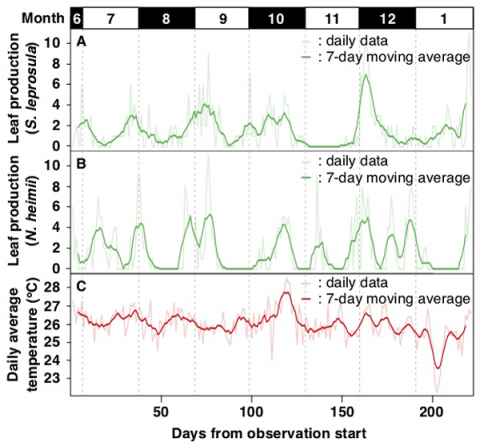Temperature-regulated leaf production in the family Dipterocarpaceae
Description
Dipterocarpaceae is a dominant tree family in Southeast Asia. This family consists of more than 500 species, many of which are important timber trees. To achieve sustainable timber production of dipterocarp species, a stable supply of planting materials is required. However, dipterocarp species flower at irregular intervals from three to ten years, which leads to difficulties in collecting seeds and providing good planting materials. To overcome the shortage of planting materials, we studied the regulation of growth in dipterocarps. Understanding their growth regulation helps to supply dipterocarp saplings by controlling their growth.For this purpose, we focused on leaf production as an indicator of plant growth. We developed an observation system using time-lapse digital cameras and monitored daily leaf production by two dipterocarp species, Shorea leprosula and Neobalanocarpus heimii (Fig. 1). To exclude the effect of rainfall variations on leaf production, we covered the observation system with transparent plastic sheets and installed it in the nursery of Forest Research Institute Malaysia (FRIM). The observation showed that leaf production by dipterocarp saplings fluctuated without variation in rainfall (Fig. 2). This suggests that the timing of leaf production cannot be explained by the rainfall pattern. Instead, we found similarities in leaf production and temperature patterns (Fig. 2). Thus, to test the effect of temperature on the timing of leaf production, we applied Convergent Cross Mapping (CCM) to the observation result. CCM is a mathematical framework to analyze causal relationships between time-series data. The CCM analysis showed that estimation skill from leaf to temperature data (cross-map skill: 0.20) was higher than that of surrogate data (cross-map skill: 0.18), suggesting a causal relationship between temperature and leaf production. The growth chamber experiments showed that leaf production was significantly increased by small increments (5˚C) in daytime or nighttime temperature from baseline temperature (daytime: 27˚C, nighttime: 24˚C) (Fig. 3). These results indicate that temperature is a regulator of leaf production.
Because our results showed that temperature affects the growth of dipterocarp saplings, if we grow the saplings in the nurseries under different temperature regimes, their growth would be varied. Thus, the establishment of multiple nurseries in different temperature conditions would diversify the supply time of good planting materials, which will contribute to a stable supply of planting materials and sustainable timber production of dipterocarps.
Figure, table
-
Fig. 1. Leaf production observation system using time-lapse digital cameras
To exclude the effect of rainfall variations on leaf production, the observation system was covered with transparent plastic sheets.
-
Fig. 2. Daily leaf production and temperature data obtained by the observation system
(A) No. of produced leaves by Shorea leprosula, (B) No. of produced leaves by Neobalanocarpus heimii, and (C) Daily average temperature. The data were obtained from June 2017 to January 2018.
-
Fig. 3. Relationship between temperature and leaf production in the growth chamber
The growth chamber experiment was conducted using 50 individuals of N. heimii. Trx indicates ~3-week temperature treatment. The experiment from Tr21 was conducted as a separate experiment. The temperatures in upper and lower triangles indicate daytime (7 AM to 7 PM) and nighttime (7 PM to 7 AM) temperatures, respectively.
- Affiliation
-
Japan International Research Center for Agricultural Sciences Forestry Division
- Classification
-
Research
- Research project
- Program name
- Term of research
-
FY2020(FY2016~FY2020)
- Responsible researcher
-
Kobayashi Masaki ( Forestry Division )
Tani Naoki ( Forestry Division )
KAKEN Researcher No.: 90343798Ng Kevin Kit Siong ( Forest Research Institute Malaysia )
Lee Soon Leong ( Forest Research Institute Malaysia )
Muhammad Norwati ( Forest Research Institute Malaysia )
- ほか
- Publication, etc.
-
Kobayashi M J et al. (2020) American Journal of Botany 107(11):1491–1503https://doi.org/10.1002/ajb2.1557
- Japanese PDF
-
2020_C07_A4_ja_0.pdf760.72 KB
2020_C07_A3_ja_0.pdf683.54 KB
- English PDF
-
2020_C07_A4_en.pdf532.35 KB
2020_C07_A3_en.pdf533.63 KB
- Poster PDF
-
2020_C07_poster.pdf610.04 KB
* Affiliation at the time of implementation of the study.


